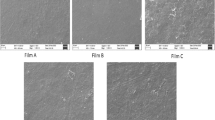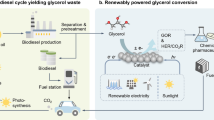Summary
1. An investigation has been made of the esterification of glycerol and peanut oil fatty acids under reduced pressure, with and without the assistance of various metal chlorides and oxides as catalysts.
2. The uncatalyzed reaction is bimolecular in character but proceeds in two successive stages, of which the latter has the lower velocity constant. Velocity constants have been determined for the initial and final stages of the reaction, at intervals between 166° and 241° C. The calculated heats of activation for the initial and final stages of the reaction are respectively 12,300 and 10,800 calories per mole. The free fatty acid concentration corresponding to the termination of the first stage decreases progressively as the temperature of the reaction is increased.
3. Of a wide variety of metal oxides and chlorides tested, zinc and tin chlorides were outstanding in catalytic activity. The reaction, when catalyzed with these materials, is complex and no longer simply bimolecular. It is believed that tin and zinc chlorides react initially with free fatty acids and free glycerol to form metal soaps and chlorohydrins, and that esterification proceeds through interaction of these two initial reaction products. Other metal chlorides, including the chlorides of aluminum, antimony, mercury, nickel, magnesium, manganese, lead, iron, and cadmium, do not appear to be capable of reacting in this manner, and are relatively poor catalysts. The oxides of tin and zinc are also deficient in catalytic activity, as is hydrochloric acid.
4. The reaction proceeds at a reasonable speed, i.e., the FFA content of the product is reduced to about 3% in 6 hours, if 0.0008 mole of tin chloride per 100 g. of fatty acids is used as a catalyst at 175° C. or if a similar amount of zinc chloride is used as a catalyst at 200° C. Equally rapid esterification is obtained without a catalyst only above 250° C. Esterification is assisted by maintaining a vacuum upon the reaction vessel to remove water vapor from the reacting material as rapidly as it is formed. A vacuum of about 20 mm. pressure of mercury is satisfactory.
5. If zinc or tin chloride catalysts are employed, the metals may be completely removed from the esterified oils by ordinary alkali refining. These catalysts do not cause the oil to polymerize during the course of esterification, do not cause conjugation in the oils, and are not detrimental to the color of the product.
Similar content being viewed by others

References
Bhattacharya, R. and Hilditch, T. P., Proc. Roy. Soc.129A, 468–76 (1930).
Blagonravova, A. A. and Lazarev, A. M., Zhurnal prikladnoi khimii (Journal of Applied Chemistry, USSR)13, 879–83 (1940).
Bradley, T. F. and Richardson, D., Ind. Eng. Chem.34, 237–42 (1942).
Eckey, E. W. and Clark, C. C. (to Procter and Gamble Co.), U. S. Pat. 2,065.520 (1936).
Fairclough, R. A. and Hinshelwood, C. N., J. Chem. Soc.1939, 593–600.
Garner, T. L., J. Soc. Chem. Ind.47, 278T-80T (1928).
Gruber, F., Fr. Pat. 677,711 (1929).
Hinshelwood, C. N. and Legard, A. R., J. Chem. Soc.1935, 587–96.
I. G. Farbenindustrie A.-G., Fr. Pat. 654,535 (1928); Ger. Pats. 514,403 and 556,558 (1930).
Johnson, J. Y., Brit. Pat. 302,411 (1928).
Kass, J. P., in “Protective and Decorative Coatings,” edited by J. J. Mattiello, Wiley, New York, Vol. IV, pp. 362–405 (1944).
Long, J. S., Kittelberger, W. S., Scott, L. K., and Egge, W. S., Ind. Eng. Chem.21, 950–55 (1929).
Mitchell, J. H., {jrJr.} and Kraybill, H. R., J. Am. Chem. Soc.64, 988–94 (1942).
Smith, H. A. and Reichardt, C. H., J. Am. Chem. Soc.63, 605–08 (1941).
Author information
Authors and Affiliations
Additional information
One of the laboratories of the Bureau of Agricultural and Industrial Chemistry, Agricultural Research Administration, U. S. Department of Agriculture.
About this article
Cite this article
Feuge, R.O., Kraemer, E.A. & Bailey, A.E. Modification of Vegetable oils. IV. Reesterification of fatty acids with glycerol. Oil Soap 22, 202–207 (1945). https://doi.org/10.1007/BF02641736
Published:
Issue Date:
DOI: https://doi.org/10.1007/BF02641736



